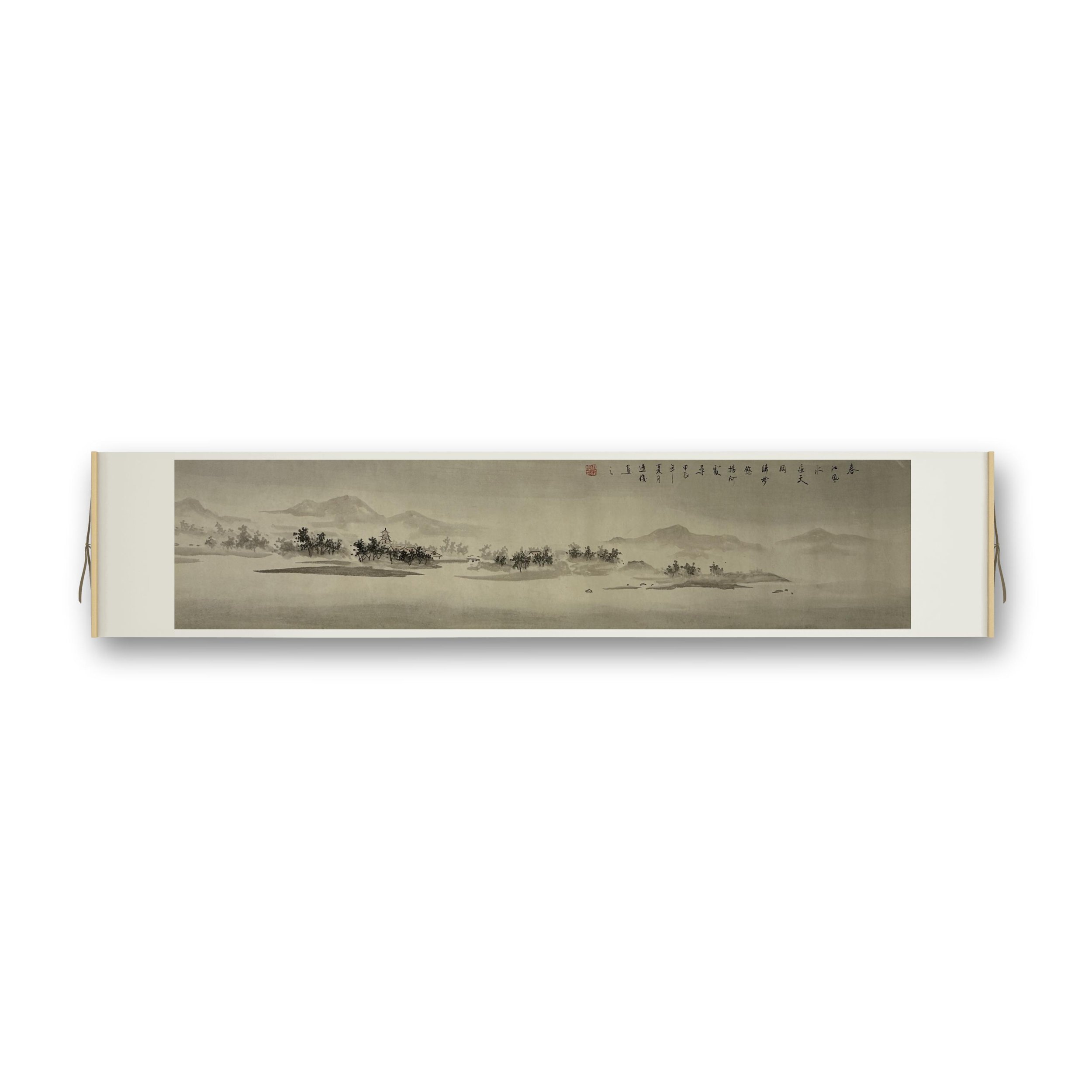烟水孤洲 Tranquil Isles in Misty Waters
Core size:35cm*138cm
This painting showcases another beautiful traditional Chinese scroll painting, combining landscape with architectural elements.
Subject and Composition
The painting appears to depict a serene landscape, including dramatic rocky cliffs, winding paths, and a solitary pavilion nestled within the natural surroundings. The use of scale creates depth, with large, textured rocks in the foreground, smaller hills in the middle ground, and hazy, distant mountains. This design invites the viewer to wander mentally through the scene, reflecting a hallmark of Chinese landscape art: the journey of the soul through nature.
Artistic Style
This piece may fall under the Shanshui (山水) style, which translates to “mountain and water painting.” The technique combines fine brushwork for details (e.g., the pavilion and trees) with expressive, free brushstrokes for the rocks and cliffs. It also integrates color washes to accentuate the natural vibrancy of the setting, suggesting it could belong to the Southern School of Chinese painting, renowned for its more lyrical and expressive approach.
Symbolism and Philosophy
Nature and Solitude: The inclusion of the lone pavilion emphasizes harmony between man and nature, a central concept in Chinese philosophy, particularly Daoism.
Cliffs and Water: The dynamic interplay between rugged terrain and calm waters may symbolize resilience and balance in life.
Journey and Reflection: The pathways subtly suggest a spiritual or intellectual journey, encouraging the viewer to pause and reflect on life’s mysteries.
Inspiration or Influence
This style of scroll painting is reminiscent of works by artists like Wang Hui or Shen Zhou, who celebrated idealized natural landscapes as spaces for meditation and escape from societal concerns. It could also be influenced by earlier Song Dynasty painters known for their precise brushwork and subtle use of color.
Core size:35cm*138cm
This painting showcases another beautiful traditional Chinese scroll painting, combining landscape with architectural elements.
Subject and Composition
The painting appears to depict a serene landscape, including dramatic rocky cliffs, winding paths, and a solitary pavilion nestled within the natural surroundings. The use of scale creates depth, with large, textured rocks in the foreground, smaller hills in the middle ground, and hazy, distant mountains. This design invites the viewer to wander mentally through the scene, reflecting a hallmark of Chinese landscape art: the journey of the soul through nature.
Artistic Style
This piece may fall under the Shanshui (山水) style, which translates to “mountain and water painting.” The technique combines fine brushwork for details (e.g., the pavilion and trees) with expressive, free brushstrokes for the rocks and cliffs. It also integrates color washes to accentuate the natural vibrancy of the setting, suggesting it could belong to the Southern School of Chinese painting, renowned for its more lyrical and expressive approach.
Symbolism and Philosophy
Nature and Solitude: The inclusion of the lone pavilion emphasizes harmony between man and nature, a central concept in Chinese philosophy, particularly Daoism.
Cliffs and Water: The dynamic interplay between rugged terrain and calm waters may symbolize resilience and balance in life.
Journey and Reflection: The pathways subtly suggest a spiritual or intellectual journey, encouraging the viewer to pause and reflect on life’s mysteries.
Inspiration or Influence
This style of scroll painting is reminiscent of works by artists like Wang Hui or Shen Zhou, who celebrated idealized natural landscapes as spaces for meditation and escape from societal concerns. It could also be influenced by earlier Song Dynasty painters known for their precise brushwork and subtle use of color.
Core size:35cm*138cm
This painting showcases another beautiful traditional Chinese scroll painting, combining landscape with architectural elements.
Subject and Composition
The painting appears to depict a serene landscape, including dramatic rocky cliffs, winding paths, and a solitary pavilion nestled within the natural surroundings. The use of scale creates depth, with large, textured rocks in the foreground, smaller hills in the middle ground, and hazy, distant mountains. This design invites the viewer to wander mentally through the scene, reflecting a hallmark of Chinese landscape art: the journey of the soul through nature.
Artistic Style
This piece may fall under the Shanshui (山水) style, which translates to “mountain and water painting.” The technique combines fine brushwork for details (e.g., the pavilion and trees) with expressive, free brushstrokes for the rocks and cliffs. It also integrates color washes to accentuate the natural vibrancy of the setting, suggesting it could belong to the Southern School of Chinese painting, renowned for its more lyrical and expressive approach.
Symbolism and Philosophy
Nature and Solitude: The inclusion of the lone pavilion emphasizes harmony between man and nature, a central concept in Chinese philosophy, particularly Daoism.
Cliffs and Water: The dynamic interplay between rugged terrain and calm waters may symbolize resilience and balance in life.
Journey and Reflection: The pathways subtly suggest a spiritual or intellectual journey, encouraging the viewer to pause and reflect on life’s mysteries.
Inspiration or Influence
This style of scroll painting is reminiscent of works by artists like Wang Hui or Shen Zhou, who celebrated idealized natural landscapes as spaces for meditation and escape from societal concerns. It could also be influenced by earlier Song Dynasty painters known for their precise brushwork and subtle use of color.
Return & Exchange Policy
At Momoon Art, each painting is a one-of-a-kind creation. As such, we do not accept returns or exchanges unless the item arrives damaged during the delivery process.
If your artwork is damaged upon arrival, please contact us within [7 days] of receiving your order. We will gladly offer a refund or exchange once the damage is verified.
Thank you for understanding and supporting unique, handcrafted art!

